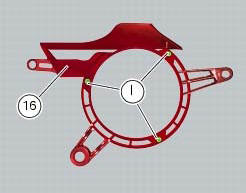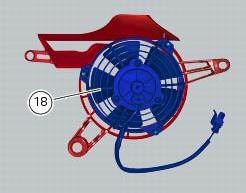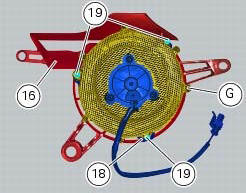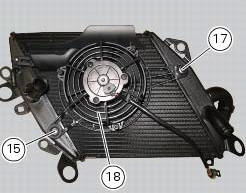
Ducati Diavel Service Manual: Renewal of the cooling fan
Loosen the electro-fan retaining screws (15) and (17) and remove the electro-fan (18) from the radiator.
Carry out the same procedure for the other radiator's electro-fan.
On refitting, position the coolant radiator fan (18) as shown on the fan support (16), so that the three fan holes match the three threaded inserts (i) of the support (16).


Position the grille (g) as shown on the coolant radiator fan (18), threading the fan cable out of the opening in the grille.
Assemble grille (g), fan (18) and fan support (16).
Tighten the screws (19) to a torque of 1 nm +/- 10% (sect. 3 - 3, Frame torque settings).

Tighten screws (15) and (17) to a torque of 5 nm +/- 10% (sect. 3 - 3, Frame torque settings).

 Disassembling the water radiator unit
Disassembling the water radiator unit
The procedure is the same for both radiators.
Loosen the screws (15), (21) and (25) to remove the air duct (24) from the right
radiator (13).
Undo the screws (12) and (14) to remove the ...
 Reassembling the water radiator unit
Reassembling the water radiator unit
The procedure is the same for both radiators.
Check the presence of clips (1) at the positions of the external coolant
radiator cover (23).
If removed, fit the front turn indicator (32) on the ...
Other materials:
Refitting the air filters
Apply universal sealant in the air duct (2) and (6) groove (d).
Fit seal (7) in the groove (d) having care to place it correctly in the relevant
seat so as to avoid abnormal wrinkles.
Pull out the filter cartridge (1) from the seat in the airbox.
Position the rh air duct (2).
Start ...
Backlighting setting function for the dashboard on handlebar - dashboard 2
This function allows backlighting setting of the dashboard on handlebar.
To access the function it is necessary to view the ""setting" menu", using
buttons (1) "s" or (2) "t" select the "back
light" function and press the reset button (3) to enter the following page.
Use button (1) "s" or ( ...
Removing the frame and the lateral footrests
Loosen the two special screws (6) to separate the frame (1) from the lateral
brackets (2) and (3).
On the left side of the vehicle block retaining pins (9) and loosen the nuts (8)
on the right side at the same time.
Slide out the retaining pins (9) and remove the frame (1) from the lateral ...